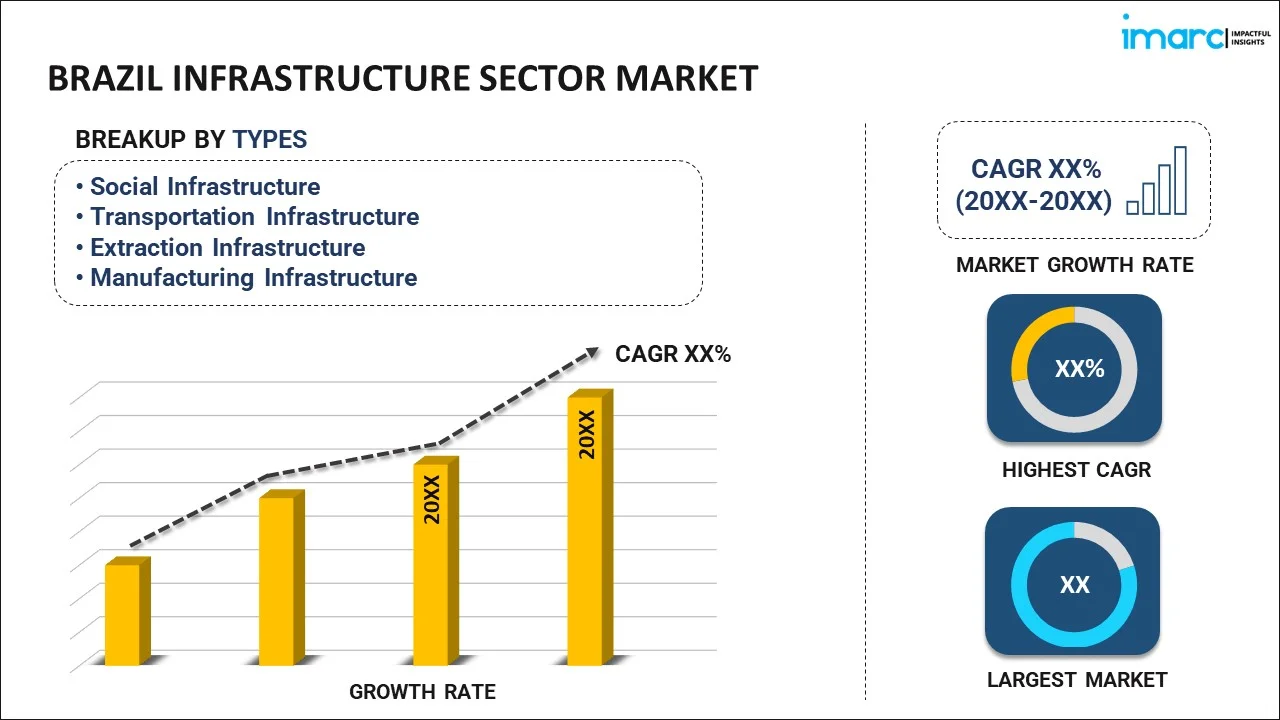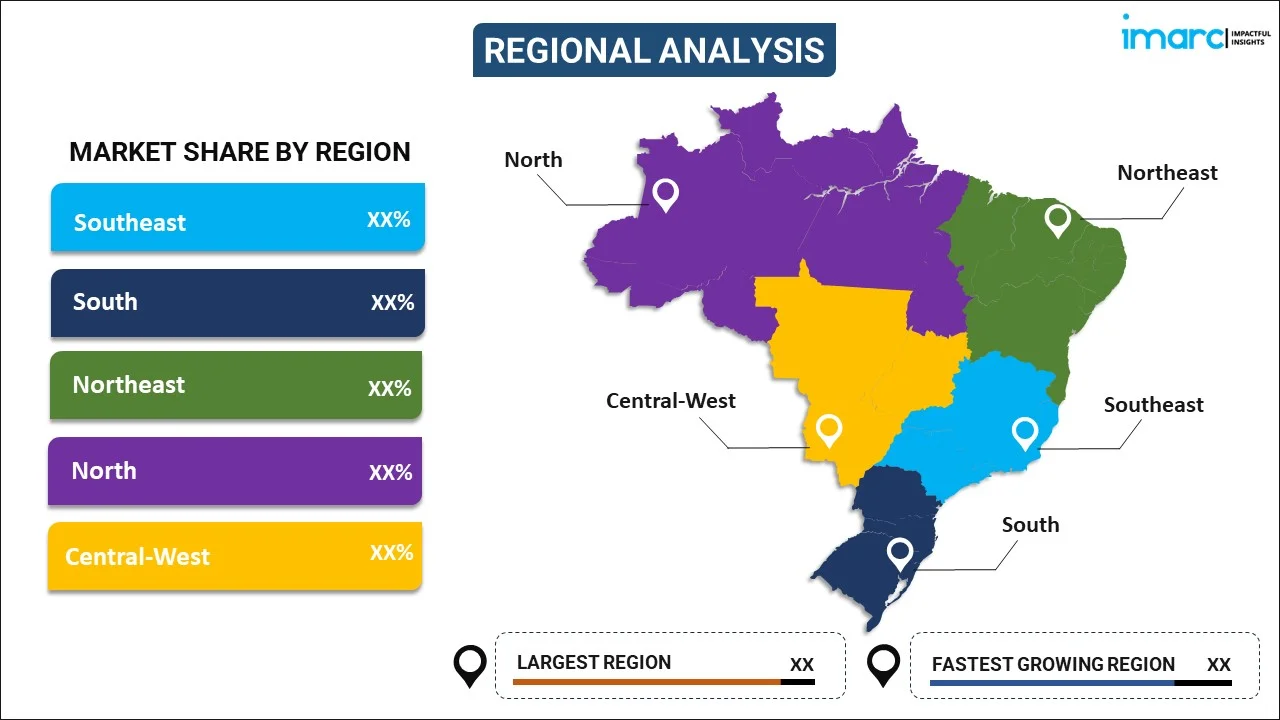
Brazil Infrastructure Sector Market Report by Type (Social Infrastructure, Transportation Infrastructure, Extraction Infrastructure, Manufacturing Infrastructure), and Region 2026-2034
Market Overview:
Brazil infrastructure sector market size reached USD 45.4 Billion in 2025. Looking forward, IMARC Group expects the market to reach USD 66.9 Billion by 2034, exhibiting a growth rate (CAGR) of 4.40% during 2026-2034. Rapid urbanization, rising government investments in renewable energy sources like wind, solar, and biomass, and a growing focus on clean water, sanitation, and transportation improvements are key drivers of the market. Moreover, as per Brazil infrastructure market analysis, Odebrecht Engenharia & Construção (OEC), Brazil's leading construction firm, plays a critical role, delivering major projects like the Humaitá submarine and the São Paulo Rodoanel Mário Covas ring road in 2024.
|
Report Attribute
|
Key Statistics
|
|---|---|
|
Base Year
|
2025
|
|
Forecast Years
|
2026-2034
|
|
Historical Years
|
2020-2025
|
|
Market Size in 2025
|
USD 45.4 Billion |
|
Market Forecast in 2034
|
USD 66.9 Billion |
| Market Growth Rate 2026-2034 | 4.40% |
The infrastructure sector is a broad economic category that encompasses the fundamental physical and organizational systems, facilities, and structures required for the efficient functioning of a society, region, or industry. It includes roads, highways, bridges, railways, airports, seaports, and public transit systems that facilitate the movement of people and goods. It also encompasses electricity grids, water supply networks, wastewater treatment facilities, and gas pipelines that support daily life and economic activities. Besides this, it involves high-speed internet access, data networks, and communication systems, which support connectivity, information exchange, and digital services. It can mitigate the impact of disasters, enabling swift recovery and reducing societal vulnerabilities. It enhances productivity, reduces transportation costs, and attracts investment. In addition, it ensures access to medical services and contributes to public health.
Brazil Infrastructure Sector Market Trends:
Rising Focus on Sustainability
According to the Brazil infrastructure sector market analysis, sustainability is becoming a key trend, driven by both governmental regulations and consumer demand for environmentally friendly projects. Brazil is investing heavily in green infrastructure, focusing on renewable energy sources such as wind, solar, and biomass to reduce carbon footprints. The demand for sustainable building materials and energy-efficient technologies is also growing. Government initiatives and international commitments to the Paris Agreement are pushing companies to adopt greener construction practices. Companies are increasingly incorporating environmental impact assessments and striving for certifications like LEED (Leadership in Energy and Environmental Design) to enhance project sustainability. Additionally, Brazil infrastructure sector market forecast highlights projects aimed at water management and waste treatment to prove integral to Brazil’s development plans, promoting a cleaner and more sustainable environment.
Expanding Digital Infrastructure
Infrastructure sector market in Brazil is accelerating due to rapid digital infrastructure. With the rise of smart cities, the need for high-speed internet, and the integration of digital technologies into public services, Brazil is focusing on enhancing its digital infrastructure. The government is prioritizing the expansion of broadband access, especially in remote areas, through initiatives like the National Broadband Plan. Smart grids, IoT devices for traffic management, and digital healthcare services are also gaining momentum. These technological advancements improve efficiency in urban planning, transportation systems, and energy management, contributing to sustainable growth. Private and public sectors are collaborating to develop integrated digital solutions, making Brazil a leader in digital transformation within the region, driving innovation and better connectivity for its growing urban population.
Public-Private Partnerships
Public-private partnerships (PPPs) are playing an increasingly important role in Brazil infrastructure sector market growth. With the government facing budget constraints, PPPs offer a viable model to fund large-scale projects, especially in transportation, energy, and sanitation. By collaborating with private investors, Brazil can leverage advanced technology, efficiency, and expertise to improve infrastructure quality. Key sectors like roads, airports, and water supply are benefiting from this collaboration, with projects such as the expansion of São Paulo's Rodoanel and the construction of new airport terminals. The Brazilian government has streamlined the regulatory process for PPPs, creating a more attractive investment environment. As these partnerships grow, they are expected to accelerate infrastructure development while ensuring long-term sustainability and economic growth.
Brazil Infrastructure Sector Market Segmentation:
IMARC Group provides an analysis of the key trends in each segment of the market, along with forecasts at the country level for 2026-2034. Our report has categorized the market based on type.
Type Insights:

To get more information on the segement analysis of this market, Request Sample
- Social Infrastructure
- Schools
- Hospitals
- Defence
- Others
- Transportation Infrastructure
- Railways
- Roadways
- Airports
- Waterways
- Extraction Infrastructure
- Power Generation
- Electricity Transmission and Distribution
- Water
- Gas
- Telecoms
- Manufacturing Infrastructure
- Metal and Ore Production
- Petroleum Refining
- Chemical Manufacturing
- Industrial Parks and Clusters
- Others
The report has provided a detailed breakup and analysis of the market based on the type. This includes social infrastructure (schools, hospitals, defence, and others), transportation infrastructure (railways, roadways, airports, and waterways), extraction infrastructure (power generation, electricity transmission and distribution, water, gas, and telecoms), and manufacturing infrastructure (metal and ore production, petroleum refining, chemical manufacturing, industrial parks and clusters, and others).
Regional Insights:

- Southeast
- South
- Northeast
- North
- Central-West
The Southeast is the economic powerhouse of Brazil, contributing significantly to its infrastructure market. It includes major cities like São Paulo and Rio de Janeiro, which are hubs for construction, energy, transportation, and logistics projects. With the highest GDP, this region attracts substantial investments in public and private infrastructure, focusing on urban development, transportation networks, and sustainable energy solutions. Its advanced infrastructure projects are vital for Brazil’s economic growth and industrial expansion.
The South region of Brazil, home to cities like Curitiba and Porto Alegre, is known for its robust industrial sector and a rising demand for infrastructure development. The region's focus is on modernizing transportation systems, expanding housing, and enhancing environmental sustainability. With a growing middle class, there’s an increasing demand for high-quality infrastructure solutions, particularly in the construction of residential complexes, commercial spaces, and green energy projects, contributing to regional economic stability.
Competitive Landscape:
The market research report has also provided a comprehensive analysis of the competitive landscape in the market. Competitive analysis such as market structure, key player positioning, top winning strategies, competitive dashboard, and company evaluation quadrant has been covered in the report. Also, detailed profiles of all major companies have been provided.
Brazil Infrastructure Sector Market News:
- In May 2025, Brazil is pushing a $35.4 Billion infrastructure modernization strategy to transform its ports and airports into global trade hubs by 2026. The plan includes 60 auctions, with major projects like the $1 Billion Santos-Guarujá immersion tunnel and $3.3 Billion in port upgrades. The strategy aims to boost Brazil’s trade routes, with 90% of funding from private capital. By 2035, the government plans a 30% increase in agricultural exports, alongside continued legal reforms and investor-friendly policies.
- In January 2024, São Paulo state secured USD 480 Million from the IDB to repair 470 km of highways. The 24-year financing is part of a larger USD 1.4 Billion road investment program, aimed at improving 2,200 km of state highways. The project, managed by the DER-SP department, aligns with São Paulo's commitment to enhancing its road infrastructure.
- The National Logistics Plan (PNL) 2035, developed by the Logistics Planning Company (EPL) in partnership with the Ministry of Infrastructure, is a strategic framework developed by Brazil's Logistics Planning Company (EPL) to guide the country’s transportation system through 2035. The plan focuses on integrating different transport modes, reducing logistics costs, and promoting sustainability. It includes key projects aimed at improving operational efficiency, intermodality, and safety. For freight forwarders and customs brokers, understanding PNL 2035 is essential to anticipate demand, optimize routes, and adapt to regulatory and infrastructure changes. The plan also addresses future scenarios, such as technological advancements and private sector participation, to enhance logistics services and support Brazil’s long-term socio-economic development.
Brazil Infrastructure Sector Market Report Coverage:
| Report Features | Details |
|---|---|
| Base Year of the Analysis | 2025 |
| Historical Period | 2020-2025 |
| Forecast Period | 2026-2034 |
| Units | Million USD |
| Scope of the Report | Exploration of Historical and Forecast Trends, Industry Catalysts and Challenges, Segment-Wise Historical and Predictive Market Assessment:
|
| Types Covered |
|
| Regions Covered | Southeast, South, Northeast, North, Central-West |
| Customization Scope | 10% Free Customization |
| Post-Sale Analyst Support | 10-12 Weeks |
| Delivery Format | PDF and Excel through Email (We can also provide the editable version of the report in PPT/Word format on special request) |
Key Benefits for Stakeholders:
- IMARC’s industry report offers a comprehensive quantitative analysis of various market segments, historical and current market trends, market forecasts, and dynamics of the Brazil infrastructure sector market from 2020-2034.
- The research report provides the latest information on the market drivers, challenges, and opportunities in the Brazil infrastructure sector market.
- Porter's five forces analysis assist stakeholders in assessing the impact of new entrants, competitive rivalry, supplier power, buyer power, and the threat of substitution. It helps stakeholders to analyze the level of competition within the Brazil infrastructure sector industry and its attractiveness.
- Competitive landscape allows stakeholders to understand their competitive environment and provides an insight into the current positions of key players in the market.
Key Questions Answered in This Report
According to the World Bank, Brazil has near-universal access to electricity and water, but only 54% of the population has access to safely managed sanitation. Despite strong coverage in some areas, infrastructure quality remains uneven, especially in rural regions. To meet the SDGs by 2030, Brazil needs to invest 3.7% of its GDP annually—around US$778 billion. Inefficiencies in infrastructure cost the country approximately 1.4% of GDP each year.
The Brazil infrastructure sector market is projected to exhibit a growth rate (CAGR) of 4.40% during 2026-2034.
The growth of the Brazil infrastructure sector market is fueled by rising demand for sustainable infrastructure, technological advancements in digital and smart infrastructure, government initiatives, and increased foreign investment. Additionally, public-private partnerships are accelerating large-scale projects, enhancing the overall sector’s development.
Need more help?
- Speak to our experienced analysts for insights on the current market scenarios.
- Include additional segments and countries to customize the report as per your requirement.
- Gain an unparalleled competitive advantage in your domain by understanding how to utilize the report and positively impacting your operations and revenue.
- For further assistance, please connect with our analysts.
 Request Customization
Request Customization
 Speak to an Analyst
Speak to an Analyst
 Request Brochure
Request Brochure
 Inquire Before Buying
Inquire Before Buying




.webp)




.webp)












